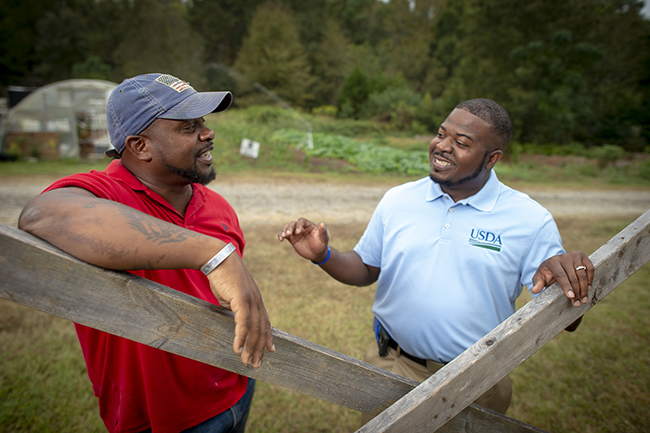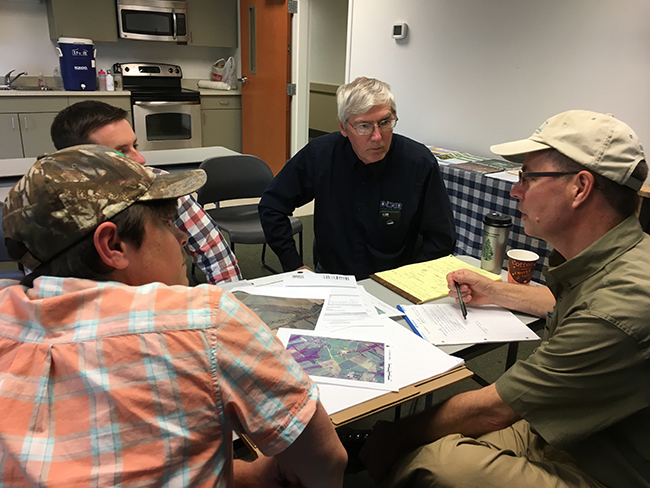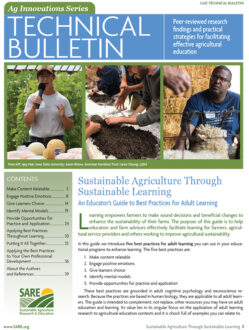
This guide is intended as a resource for ongoing use. You will enhance your effectiveness as an educator when you practice applying the five adult learning best practices before, during and after the learning interactions you design and facilitate, whether they are single events, courses or one-on-one consultations with farmers.
Some best practices can be particularly helpful before learning interactions, such as identifying participants’ mental models about the content. Other practices, such as providing opportunities for deliberate practice and applying content to genuine problems, are especially effective at sustaining learning after direct interactions. All five can be applied during events, courses and long-term consultations.
Before Learning Interactions
The planning stage is a crucial time to give attention to the best practices. At this stage, this guide can be used in two ways. First, you can enact some of the best practices to develop a profile of learners who plan to participate in your program. For example, for programs involving multiple participants, survey learners to gain an understanding of their mental models and their prior experiences related to the content, as well as their preferences in terms of content, process and/or outcomes. You can gather the same type of information prior to one-on-one interactions with a farmer via an informal “intake interview.”
Second, you can use the survey or interview results to tailor your curriculum and learning activities to the group or individual. The downloadable “Planning Grid for Using Adult Learning Best Practices in Educational Activities” (PDF) can guide you through planning how to incorporate the five best practices into a learning event, course or consultation. Use the grid to record your decisions regarding the best practices you plan to apply before, during and/or after the learning interactions. In the boxes, describe the activities you will use to put a best practice into action. Feel free to reproduce this grid and modify it in any way that works best for you.
During Learning Interactions
Adopt the mindset that your objective is to facilitate learning rather than to “cover the content.”
Review the guide shortly before you meet with learners to prepare yourself to respond to new learning needs and opportunities that may arise during the interaction. Having a solid plan based on the best practices is essential, and so too is the ability to apply the best practices on the fly as you adapt to learners’ needs and experiences in real time. Keep the social and emotional climate positive and remember that even a small surprise unrelated to the content can be a powerful motivator for learning.
Remain mindful that participants will make sense of new information based on their prior experiences and that their mental models will influence their receptiveness to new information. Adopt the mindset that your objective is to facilitate learning rather than to “cover the content.” Facilitating learning may require a shift in how you manage time. Allot ample time for participants to share their experiences with each other, to practice key knowledge and skills, to receive feedback, and to apply their new knowledge and skills.
After Learning Interactions
At the conclusion of your educational interactions, new learning has just begun for participants. Be proactive about ensuring that support is in place for participants to continue their learning.
At the conclusion of your educational interactions, new learning has just begun for participants. Be proactive about ensuring that support is in place for participants to continue their learning. This may mean following up on take-home tasks such as completing checklists or inventories, tracking data about follow-through actions, being available for follow-up questions, or facilitating continued communications and networking among farmers through in-person or online meetings, social media platforms and listservs.
Educators sometimes struggle with supporting participants’ ongoing learning after direct interactions end. This may be for a variety of reasons, such as shifting their focus to the next event or pressing demand on their schedules, or feeling as if their job is completed once direct contact is over. The profiles in this section provide two examples of ways educators have successfully sustained participants’ learning after educational events.
Profiles
Sustaining Learning through Learning Circles
Beth Holtzman, University of Vermont Extension

When Beth Holtzman ran a train-the-trainer project to equip agricultural service providers with improved program evaluation skills, she used ongoing engagement as a central learning strategy. Educators first built their knowledge and skills about evaluation concepts and strategies through in-person workshops and follow-up interactive webinars. They were able to select topics based on their interests. To help the educators apply the learning to their work, Holtzman then organized them into virtual learning circles. Circle members initially met online to discuss how they planned to apply new concepts and skills in an upcoming evaluation-related challenge or task in their work. They shared methods and tools they planned to use and received feedback and advice from others. Initially, the learning circles met bimonthly and participants posted their planned actions and timetable in a Google Doc that Holtzman provided. The document became a tracking tool that members referred to and updated as they made progress toward their goals.
Holtzman has learned a few things from her experiences organizing the learning circles. First, it worked better when circles included two people versus three or four. This was in part because scheduling meetings was much harder for larger circles. Also, the more closely aligned partners were in their program areas and in their needs for improvement, the more successful the circles. For example, educators sharing a need for improved surveys to assess on-farm changes related to water quality formed a strong and productive learning circle. Holtzman also found that using Google Docs to record discussions and activities in the learning circles gave her a great tool for monitoring progress and identifying participants who may be struggling to complete tasks or who may need additional guidance.
For more information
SARE project: Enhancing evaluation capacity to improve sustainable agriculture programs and outcomes in Vermont (2017)
Read more: https://projects.sare.org/project-reports/nevt17-001/
Sustaining Learning Through Communication and Sharing Resources
Rachel Bespuda, University of Connecticut Extension
As described in the livestock nutrition profile shared earlier in the section about deliberate practice, Rachel Bespuda helps participants sustain their learning through a listserv that she actively manages. She established this method of communication after asking participants their preferred way to stay connected, and it helped participants form an ongoing learning community. On average, Bespuda emails the group once a month with articles, fact sheets, videos and other educational resources on topics that relate to and build upon concepts taught in the classroom and outdoor workshops. Ideas for resources to share come from not only the project team and content specialists but also from the participants themselves.
For more information
SARE project: Nutrition’s role in sustainable livestock production practices (2017)
Read more: https://projects.sare.org/sare_project/nect17-001/
